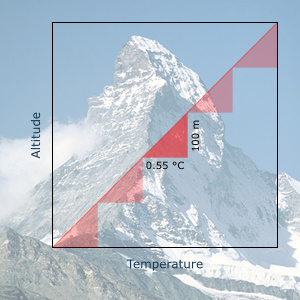Common characteristics
Summary of previous sections: Neither the radiation regime nor precipitation, wind or snow are climatic elements which change in a typical, common way across the mountain ranges of the world. These are the climatic elements responsible for regional differences in mountain climates.
What are the uniform changes with elevation, common to all mountains?
These are: the reduction of temperature and atmospheric pressure.
Atmospheric pressure
Atmospheric pressure is reduced from sea level values of c. 1000 hPa (1 bar) by c. 10 % for every 1000 m in elevation. At 2600 m total atmospheric pressure is roughly 26 % less than at sea level.
Implications: At equal temperature, molecular diffusion is faster (fewer molecular collisions). Partial pressures of oxygen and CO2 decrease as well.
Note: The mixing ratio of gases in the atmosphere does not change with elevation in the range of biologically relevant altitudes. Example: The current (2011) mixing ratio of CO2 is c. 390 ppm (= µl l-1) at all altitudes, but the partial pressure is reduced from 390 µbar at sea level to c. 305 µbar at 2600 m.

Temperature
Reduced atmospheric pressure also contributes to what is known as the "adiabatic lapse rate of temperature". In most mountain ranges of the world, temperature declines by a mean of 0.55 K per 100 m of elevation. This gradient may not apply to cold winter weather when low elevation temperatures may be lower than mountain temperatures due to so-called temperature inversion (cold air in mountain basins and valleys).

